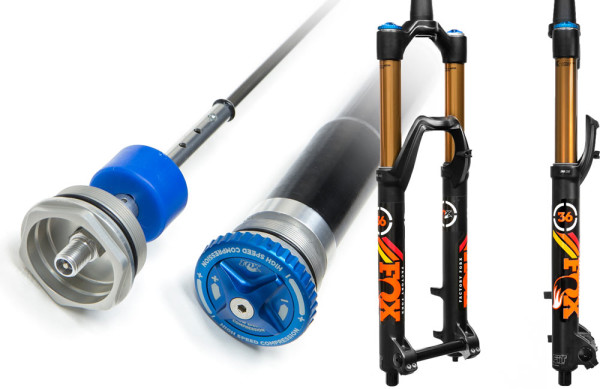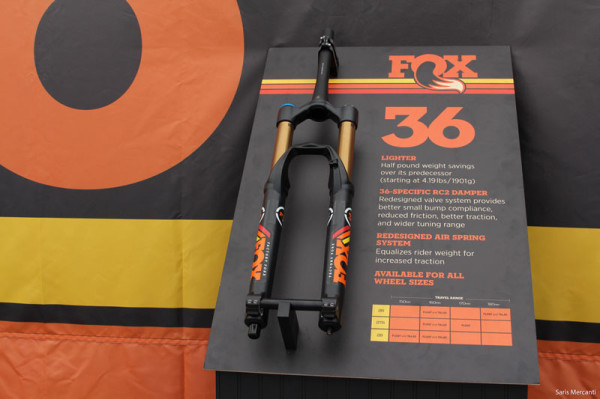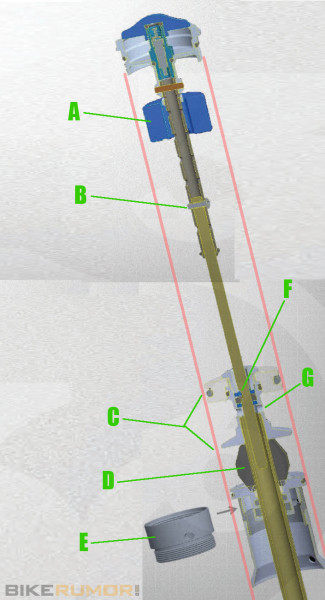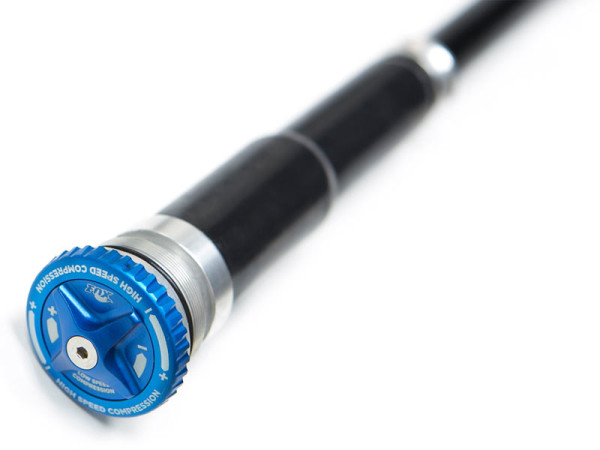So far, we’ve posted quite a bit of detail on the new Fox 36 fork platform. There was the official launch, followed by Sea Otter’s in depth look at most of the upgrades. Until now, though, Fox was keeping mum on how, exactly, the new FLOAT air suspension system had been updated and keeping the internals away from prying eyes.
Over the past few years, Fox has updated the 32 and 34 series forks, leaving the 36 untouched. For most riders, those thinner stanchions met their needs while offering a lighter weight fork. Fox’s Mark Jordan told us part of the delay in updating the 36 was resources. As in, their time and energy were going into the other models. The other part of it was waiting to see what the market really wanted and needed. Did 29ers really need a 36mm stanchion, 160mm travel fork? And what travel options would the burgeoning 27.5″ movement need?
With those questions seemingly answered, they turned their attention to updating the FLOAT system. FLOAT stands for “FOX Load Optimized Air System” and has been their go-to air design for ages. In fact, air shocks is what started the company and set it apart in motocross. This latest iteration takes everything a big step forward to a full air system. That’s right, no more coil negative.
Last year, the 36 is the fork that needed to catch up to the others. Now it’s leading the pack with all the latest technology…
Two main features are unique to the 2015 Fox 36 forks:
- It’s the only one that has a convertible thru axle
- It’s the first to get the new FLOAT air system
But that’s not the entire story. It lost more than half a pound by incorporating many of the chassis changes introduced in 2013/14 models for the 32 and 34 range. Actually, the 40 was the first to receive the full chassis overhaul. It introduced a quad tapered lower (still magnesium cast) that allowed for far more shaping on the inside of the casting without causing porosity or weak spots. How, exactly, is a trade secret they won’t reveal, but essentially as casting technology evolved, Fox took full advantage of it. With the new 36, it went from a quad tapered lower to a quintuple tapered design.
All told, the changes dropped significant weight from the fork. Here’s the breakdown according to Fox:
- 1.5″ tapered steerer = 34g lighter
- 1.5″ crowns = 45g lighter
- Upper tube set = 114g lighter
- Lower leg = 98g lighter
- 20mm thru-axle and hardware = 65g lighter than 20QR system
- FLOAT air spring = 94g lighter
Grand total: 385g (0.85 pounds) on a 15mm thru axle fork. That’s a lot of heft off the front end of the bike, which should make a dramatic improvement to handling and overall bike feel. Additionally, moving to 180mm disc brake direct mount eliminates the need for an adapter and longer bolts, which also saves a few grams from the complete bike.
NEW FLOAT AIR SUSPENSION
The new air spring is still called FLOAT, but it’s a far cry from the original. The big change is a move to a full air system, eliminating the coil negative spring. Not only does this drop weight, but it makes for a more tunable, more consistent fork. Much like their rear shocks, the full air FLOAT system uses a small check (aka bypass) valve to let air automatically fill the negative chamber to an equal air pressure when the fork’s deep into its compression.
Here’s what you’re looking at: Imagine the pink lines are the sides of the stanchion. The main air chamber is up top, shown with a preinstalled Travel Volume Spacer (A). Below the main piston is the Negative Air Chamber (C). Air slips from the positive to the negative when the check valve (F) passes over small ports (G). All of that lands on the Top Out Bumper (D). The Bottom Out Bumper is further down, and prevents the hard parts from smashing together if things get really crazy.
The benefits of this are many. First, it means the negative is automatically balanced for any rider weight – versus picking one coil spring rate to fit everyone. Second, there’s now a consistent axle-to-crown height regardless of air pressure. With older models, higher air pressure could raise it up a bit, and vice versa. Lastly, it means you can use volume spacers more effectively to tune the fork’s progression. Two sizes are available, and forks include four of the smaller ones with purchase – one installed and three in the box. Before, they would tell mechanics to use “X” amount of FLOAT fluid in the air chamber to take up space. Not only was that method far less precise, but they no longer use the old FLOAT fluid oil inside the air chamber to keep the piston sliding easily. Now, it’s a grease, which is a bit cleaner and also saves weight, and spacers are far more precise. They’re also user friendly – air volume changes can be done by simply removing the top cap of the air chamber (after releasing the air pressure!) then popping them onto the shaft. Couple minutes, tops.
On top of all that, Fox says the new dual air design reduces vibration transmission through the fork up to the handlebars for a smoother ride.
Only the FLOAT models use the new air spring. The TALAS models still use a coil negative spring, for now. Jordan says Fox is very happy with the new hydraulic TALAS system introduced last summer and no immediate plans are in place to change it. That said, we’re seeing the 36 take advantage of all the chassis changes the other models brought about, so it wouldn’t be surprising to see those models getting the new air tech in the near future.
TRAVEL ADJUSTMENTS
Another big change is the ability to change the fork’s travel internally. You do need to drop the lowers, but with the RC2 FIT damping cartridge fully enclosed, it’s not a messy process. The cutaway above shows the two spots that need to change: First, you add a 10mm Travel Spacer (E) to raise the bottom out height, effectively reducing travel. Second, you move the inner shaft up a slot and bolt it back in (B). This realigns the check valve for the negative air chamber, ensuring pressure equalization. We’re confirming, but from the looks of the design, reducing travel would reduce the positive air chamber’s volume, resulting in a firmer, more progressive fork the shorter you take it.
The 36’s come set at either 160mm or 180mm of travel. Both use the same lowers but get two different air springs and dampers that are designed specifically for the travel range the fork was built for. Internally, they can be adjusted downward in 10mm increments, for a max of 50mm travel reduction. So, the 160 can’t be adjusted to have more travel, but you could bring it all the way down to 110mm if you want. Fox says many folks were using these for dirt jump and wanted something a bit shorter but with the sturdy legs a 36mm stanchion offers. Or, 29er riders might want a 130mm fork. And the air tuning spacers help adjust the ramp to suit the travel.
For TALAS versions, the prior year 36’s had a 40mm travel change when lowered. Now, they come set with 30mm drops, but with a spacer inside that can be removed to bring it back up to 40mm of change if desired. It can be adjusted with more spacers in 5mm increments to fine tune the amount of travel adjust when throwing the switch.
UPDATED RC2 DAMPER
The RC2 damper gets a new seal head that has lower friction while using a longer bushing. In addition to the new physical parts, they switched to a 20-weight gold oil, which is tackier than the red or green they use for other things. That sounds counterintuitive, but it helps the lube stay up where it’s needed rather than let gravity pull it out of its optimum position. The design came from the RAD prototypes their pros were using on 34’s the prior season. This feature should end up on all 2015 forks.
It uses a lower viscosity damper oil to work better when it heats up, particularly during rebound. As oil heats up, the viscosity naturally drops, so by starting with a lower 5-weight oil (versus 7.5 before), the change under heat is less pronounced. The damping valves were retuned for the lighter weight, so it all works together.
Side note: The different colored oils help them tell what goes where, and if someone ever calls with a service complaint, it’s easy to tell if they’ve become mixed because the colors are off.
CONVERTIBLE THRU AXLE
The forks include both 15mm and 20mm thru axles in the box and let you swap between either. The tricks to making it work are an insert to correct hub spacing for the two standards. On the left is the 15mm thru axle grouping, which uses two spacers that sit over the axle and trim the width down from 110mm (20mm thru axle standard) to 100mm. They’re lipped at the top to catch the hub’s end caps. On the bottom, a small metal shim pulls double duty: It fits into the slot between the bolts to prevent over tightening, and it lines up the axle spacers so they’re properly positioned for hub insertion. The 20mm axle, on right, uses smaller shims without the alignment tabs.
GEOMETRY, SIZES & PRICING
Fork rake is the same as the 34 series forks, so you could swap in the 36 with virtually no change in handling. The axle to crown length actually shrunk thanks to a lower profile press-in section where the steerer tube attaches. Not only does that contribute to the weight savings, but helps keep the front end of bigger wheeled bikes (aka 29ers) a bit lower. It also means most folks could swap to a 36 and add 10mm more travel without jacking their front end up. That’s especially important in mountainous areas because you gain travel for the descents without causing the bike to wander excessively on the climbs.

They kept the 26″ models because there are still a lot of people with perfectly good bikes that may only want to upgrade the shock rather than buy a whole new bike. Heck, they even offer the 26″ wheel models with a straight steerer tube! Those models include Float 160/180, TALAS 160/180 and VAN 180. The side benefit is it’s also a good option for anyone running an angle adjustable headset that needs a straight 1-1/8″ steerer.
All 2015 36 aftermarket forks are Factory level, Fox’s top spec level with all the bells and whistles. Retail’s $1,035 for the straight steerer models, and $1,050 for tapered. TALAS is $1,150. They come with the new heritage graphics when purchased aftermarket, but various color sticker sheets are available to help match your fork and shock to your bike.
We’ve got one coming in for long term review, stay tuned for actual weights and first impressions. In the meantime, Fox’s website just took all this live with individual models’ specs:








